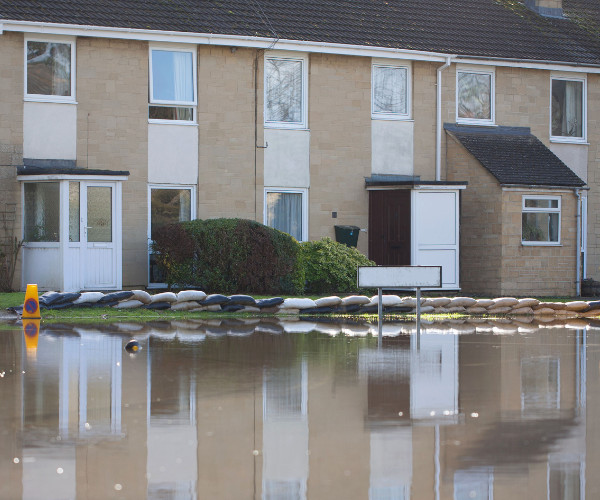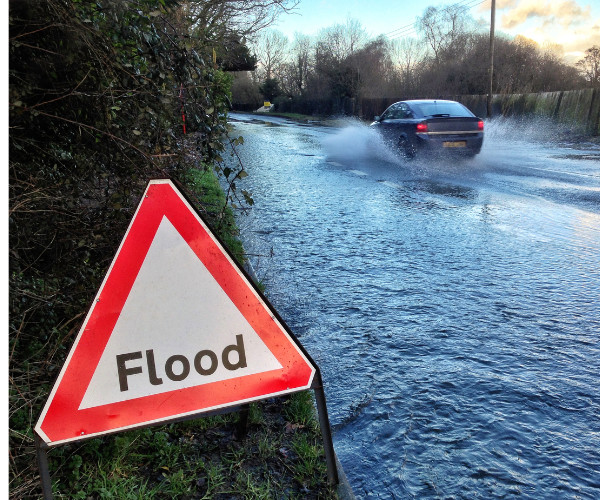Flooding has become an increasingly concerning issue in the UK, with recent extreme weather events putting thousands of homes at risk. Rising water levels, caused by heavy rainfall and inadequate drainage systems, have led to widespread damage, leaving many homeowners facing devastating losses.
As flood risks continue to grow, it’s more important than ever to understand if your home is vulnerable and whether you’re properly protected by insurance. Knowing your flood risk not only helps you take preventive measures, but also ensures that you have the right insurance coverage in place to safeguard your property and belongings from potential disaster.
In this blog, we’ll explore the growing flood risk in the UK, how to determine if your home is in danger, and the critical role insurance plays in protecting you against the unexpected.
How do you find out if you are in a flood risk area?
There are a few ways you can ascertain the risk extreme weather and flooding is to your property. Homeowners can use the government’s flood risk service website to discover the long term risk of flooding, the possible causes of flooding, and methods for managing flood risk. The website will also tell you about the risk from different types of water, including rivers, sea, surface water, and reservoirs.
What are the most at-risk flood areas in the UK?
There are many areas of the UK that are at risk of flooding from different water sources.
Coastal flood risk areas include:
- Cornwall
- East Coast regions (such as Hull and Great Yarmouth)
- Kent
- Sussex
River flood risk areas include:
- Somerset
- Essex
- Norfolk
Surface water flood risk areas include:
- Cumbria
- Lincolnshire
- Yorkshire
What does flood risk zone 3 mean?
Zone 3 is a risk level for flooding categorised by the government. The categories are:
- Zone 3b – High risk (over 3.3%)
- Zone 3 – Medium risk (between 1% and 3.3%)
- Zone 2 – Low risk (between 0.1% and 1%)
- Zone 1 – Very low risk (less than 0.1%)
Can you find out if your house has flooded before?
Your estate agent has an obligation to mention in the property listing whether your home has previously been flooded, as stated in the Consumer Protection from Unfair Trading Regulations 2008. You can also find this information in the TA6 property information form that is given to you by the seller.
Your conveyancer may also have conducted an Environmental Search after your offer was accepted, which will tell you the risk of flooding from various sources such as coastal/river, surface water, or groundwater.

How can you protect your home against flooding?
Protecting your home from flooding involves a combination of preventive measures, home modifications, and emergency preparedness. Here are some key steps you can take to minimise the risk of flood damage:
1. Assess Your Flood Risk
- Check Flood Maps: Use online tools like the UK government’s flood risk map to determine if your home is in a high-risk area.
- Understand Local Factors: Consider the proximity of rivers, lakes, and drainage systems, as well as the history of flooding in your area.
2. Install Flood-Resistant Products
- Flood Barriers: Install flood gates or barriers at doors, windows, and other entry points to prevent water from entering.
- Airbrick Covers: Fit removable airbrick covers to stop flood water from coming through ventilation points.
- Non-Return Valves: Install non-return valves in drains, pipes, and toilets to prevent sewage and floodwater from backing up into your home.
3. Elevate Key Equipment
- Raise Electrical Outlets: Move electrical sockets, switches, and wiring at least 1.5 metres above floor level.
- Relocate Appliances: If possible, elevate appliances like washing machines and boilers to minimise damage.
- Waterproof Your Basement: Install a sump pump and waterproof membrane in basements to prevent flooding.
4. Improve Drainage Around Your Property
- Permeable Driveways: Use permeable materials like gravel or porous pavement for driveways and paths to allow water to drain more effectively.
- Maintain Gutters and Drains: Regularly clean gutters and downspouts to ensure water can flow freely away from your home.
- Landscaping Adjustments: Modify your landscaping to divert water away from your property, such as creating slopes or installing French drains.
5. Prepare for Emergencies
- Flood Alerts: Sign up for flood warnings through the Environment Agency’s alert system.
- Emergency Plan: Create an emergency flood plan for your family, including evacuation routes and a safe place to stay.
- Sandbags: Keep sandbags on hand to create a temporary barrier if flooding is imminent.
6. Review and Update Your Insurance
- Flood Insurance: Ensure that your home insurance policy includes coverage for flood damage. Some policies may exclude floods or require additional coverage.
- Contents Insurance: Consider insuring your belongings, as standard policies may not cover personal items damaged in a flood.
By taking these proactive measures, you can significantly reduce the impact of flooding on your home and protect your family from the distress of water damage.

How does flood risk insurance work in the UK?
Flood insurance is usually included as a standard feature of your buildings insurance, which protects you against the costs associated with repairing damage to your property, including removing any debris, repairing structural elements that have been damaged, and any fees associated with surveyors or solicitors.
Buildings insurance, however, does not cover the contents of your home, which will need to be covered by contents insurance. Your belongings may be replaced as part of a ‘new for old’ policy whereby the insurance company will pay out to replace damaged items with new items. However, you might only have indemnity cover, which means you will only get the value of the items before the flood. For example, your replacement washing machine might cost £500 but your old one was only worth £100 at the time of the flood.
Do you need flood risk insurance?
This really depends on where in the UK you live and how often your location has flooded in the past. As mentioned above, the government website will help you find out whether your area is at risk, but in general you can’t be too careful when it comes to weather damage. From your home being uninhabitable for a time, to your treasured possessions being destroyed by water damage, the added pressure of paying out of pocket to get things back to normal can’t be understated.
The most important element of finding flood risk insurance is to shop around to make sure you are getting the best deal. Working with an insurance company that specialises in flood cover is vital, as they are in the best position to ensure you receive the policy you need.
With large-scale weather events becoming more frequent, you need to know you are protected. Fill out our form today to be contacted by our panel of partners, so you can choose the quote that’s right for you.